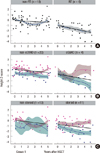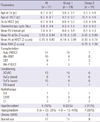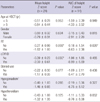1. Bernard F, Bordigoni P, Simeoni MC, Barlogis V, Contet A, Loundou A, Thuret I, Leheup B, Chambost H, Play B, et al. Height growth during adolescence and final height after haematopoietic SCT for childhood acute leukaemia: the impact of a conditioning regimen with BU or TBI. Bone Marrow Transplant. 2009. 43:637–642.
2. Sanders JE, Guthrie KA, Hoffmeister PA, Woolfrey AE, Carpenter PA, Appelbaum FR. Final adult height of patients who received hematopoietic cell transplantation in childhood. Blood. 2005. 105:1348–1354.
3. Bakker B, Oostdijk W, Bresters D, Walenkamp MJ, Vossen JM, Wit JM. Disturbances of growth and endocrine function after busulphan-based conditioning for haematopoietic stem cell transplantation during infancy and childhood. Bone Marrow Transplant. 2004. 33:1049–1056.
4. Cohen A, Rovelli A, Bakker B, Uderzo C, van Lint MT, Esperou H, Gaiero A, Leiper AD, Dopfer R, Cahn JY, et al. Final height of patients who underwent bone marrow transplantation for hematological disorders during childhood: a study by the Working Party for Late Effects-EBMT. Blood. 1999. 93:4109–4115.
5. Chemaitilly W, Boulad F, Heller G, Kernan NA, Small TN, O'Reilly RJ, Sklar CA. Final height in pediatric patients after hyperfractionated total body irradiation and stem cell transplantation. Bone Marrow Transplant. 2007. 40:29–35.
6. Couto-Silva AC, Trivin C, Esperou H, Michon J, Baruchel A, Lemaire P, Brauner R. Final height and gonad function after total body irradiation during childhood. Bone Marrow Transplant. 2006. 38:427–432.
7. De Simone M, Verrotti A, Iughetti L, Palumbo M, Di Bartolomeo P, Olioso P, Rosato T. Final height of thalassemic patients who underwent bone marrow transplantation during childhood. Bone Marrow Transplant. 2001. 28:201–205.
8. Frisk P, Arvidson J, Gustafsson J, Lonnerholm G. Pubertal development and final height after autologous bone marrow transplantation for acute lymphoblastic leukemia. Bone Marrow Transplant. 2004. 33:205–210.
9. Tauchmanova L, Selleri C, Rosa GD, Pagano L, Orio F, Lombardi G, Rotoli B, Colao A. High prevalence of endocrine dysfunction in long-term survivors after allogeneic bone marrow transplantation for hematologic diseases. Cancer. 2002. 95:1076–1084.
10. Sanders JE, Pritchard S, Mahoney P, Amos D, Buckner CD, Witherspoon RP, Deeg HJ, Doney KC, Sullivan KM, Appelbaum FR, et al. Growth and development following marrow transplantation for leukemia. Blood. 1986. 68:1129–1135.
11. Adan L, de Lanversin ML, Thalassinos C, Souberbielle JC, Fischer A, Brauner R. Growth after bone marrow transplantation in young children conditioned with chemotherapy alone. Bone Marrow Transplant. 1997. 19:253–256.
12. Shalitin S, Phillip M, Stein J, Goshen Y, Carmi D, Yaniv I. Endocrine dysfunction and parameters of the metabolic syndrome after bone marrow transplantation during childhood and adolescence. Bone Marrow Transplant. 2006. 37:1109–1117.
13. Huma Z, Boulad F, Black P, Heller G, Sklar C. Growth in children after bone marrow transplantation for acute leukemia. Blood. 1995. 86:819–824.
14. Afify Z, Shaw PJ, Clavano-Harding A, Cowell CT. Growth and endocrine function in children with acute myeloid leukaemia after bone marrow transplantation using busulfan/cyclophosphamide. Bone Marrow Transplant. 2000. 25:1087–1092.
15. Leung W, Hudson MM, Strickland DK, Phipps S, Srivastava DK, Ribeiro RC, Rubnitz JE, Sandlund JT, Kun LE, Bowman LC, et al. Late effects of treatment in survivors of childhood acute myeloid leukemia. J Clin Oncol. 2000. 18:3273–3279.
16. Lee DH, Chung NG, Cho B, Kim HK, Kang HJ, Shin HY, Ahn HS, Yoo KH, Sung KW, Koo HH, et al. Idarubicin plus behenoyl cytarabine and 6-thioguanine compares favorably with idarubicin plus cytarabine-based regimen for children with previously untreated acute myeloid leukemia: 10-year retrospective, multicenter study in Korea. J Korean Med Sci. 2010. 25:9–15.
17. Korea Center for Disease Control and Prevention TKPS, The Committee for the Development of Growth Standard for Korean Children and Adolescents. 2007 Korean Children and Adolescents Growth Standard. Government report online. 2007. accessed on 4 October 2012. Seoul: Division of Chronic Disease Surveillance;Available at
http://www.cdc.go.kr/webcdc/.
18. Greulich WW, Pyle SI. Radiographic atlas of skeletal development of the hand and wrist. 1959. 2nd ed. California: Standford University Press.
19. Marshall WA, Tanner JM. Variations in pattern of pubertal changes in girls. Arch Dis Child. 1969. 44:291–303.
20. Marshall WA, Tanner JM. Variations in the pattern of pubertal changes in boys. Arch Dis Child. 1970. 45:13–23.
21. Lee SJ, Vogelsang G, Flowers ME. Chronic graft-versus-host disease. Biol Blood Marrow Transplant. 2003. 9:215–233.
22. Matthews JN, Altman DG, Campbell MJ, Royston P. Analysis of serial measurements in medical research. BMJ. 1990. 300:230–235.
23. Senn S, Stevens L, Chaturvedi N. Repeated measures in clinical trials: simple strategies for analysis using summary measures. Stat Med. 2000. 19:861–877.
24. Siebler T, Shalet SM, Robson H. Effects of chemotherapy on bone metabolism and skeletal growth. Horm Res. 2002. 58:80–85.
25. Roman J, Villaizan CJ, Garcia-Foncillas J, Salvador J, Sierrasesumaga L. Growth and growth hormone secretion in children with cancer treated with chemotherapy. J Pediatr. 1997. 131:105–112.
26. Bakker B, Massa GG, Oostdijk W, Van Weel-Sipman MH, Vossen JM, Wit JM. Pubertal development and growth after total-body irradiation and bone marrow transplantation for haematological malignancies. Eur J Pediatr. 2000. 159:31–37.
27. Chow EJ, Friedman DL, Yasui Y, Whitton JA, Stovall M, Robison LL, Sklar CA. Decreased adult height in survivors of childhood acute lymphoblastic leukemia: a report from the Childhood Cancer Survivor Study. J Pediatr. 2007. 150:370–375.
28. Narumi S, Shimada H, Shimasaki N, Takahashi T, Hasegawa T, Mori T. Growth-chart-based qualitative evaluation of height growth after hematopoietic stem cell transplantation. Pediatr Transplant. 2006. 10:26–31.
29. Bell J, Parker KL, Swinford RD, Hoffman AR, Maneatis T, Lippe B. Long-term safety of recombinant human growth hormone in children. J Clin Endocrinol Metab. 2010. 95:167–177.
30. Isfan F, Kanold J, Merlin E, Contet A, Sirvent N, Rochette E, Poiree M, Terral D, Carla-Malpuech H, Reynaud R, et al. Growth hormone treatment impact on growth rate and final height of patients who received HSCT with TBI or/and cranial irradiation in childhood: a report from the French Leukaemia Long-Term Follow-Up Study (LEA). Bone Marrow Transplant. 2012. 47:684–693.










 PDF
PDF ePub
ePub Citation
Citation Print
Print



 XML Download
XML Download